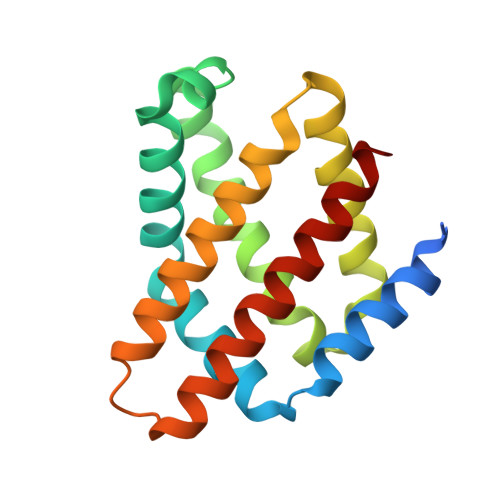Structural Insights into Oxygen-Dependent Signal Transduction within Globin Coupled Sensors.
Rivera, S., Young, P.G., Hoffer, E.D., Vansuch, G.E., Metzler, C.L., Dunham, C.M., Weinert, E.E.(2018) Inorg Chem 57: 14386-14395
- PubMed: 30378421
- DOI: https://doi.org/10.1021/acs.inorgchem.8b02584
- Primary Citation of Related Structures:
6M9A - PubMed Abstract:
In order to respond to external stimuli, bacteria have evolved sensor proteins linking external signals to intracellular outputs that can then regulate downstream pathways and phenotypes. Globin coupled sensor proteins (GCSs) serve to link environmental O 2 levels to cellular processes by coupling a heme-containing sensor globin domain to a catalytic output domain. However, the mechanism by which O 2 binding activates these proteins is currently unknown. To provide insights into the signaling mechanism, two distinct dimeric complexes of the isolated globin domain of the GCS from Bordetella pertussis ( BpeGlobin) were solved via X-ray crystallography in which differences in ligand-bound states were observed. Both monomers of one dimer contain Fe(II)-O 2 states, while the other dimer consists of the Fe(III)-H 2 O and Fe(II)-O 2 states. These data provide the first molecular insights into the heme pocket conformation of the active Fe(II)-O 2 form of these enzymes. In addition, heme distortion modes and heme-protein interactions were found to correlate with the ligation state of the globin, suggesting that these conformational changes play a role in O 2 -dependent signaling. Fourier transform infrared spectroscopy (FTIR) of the full-length GCS from B. pertussis ( BpeGReg) and the closely related GCS from Pectobacterium carotovorum ssp. carotovorum ( PccGCS) confirmed the importance of an ordered water within the heme pocket and two distal residues (Tyr43 and Ser68) as hydrogen-bond donors. Taken together, this work provides mechanistic insights into BpeGReg O 2 sensing and the signaling mechanisms of diguanylate cyclase-containing GCS proteins.
Organizational Affiliation:
Department of Chemistry , Emory University , Atlanta , Georgia 30322 , United States.

















